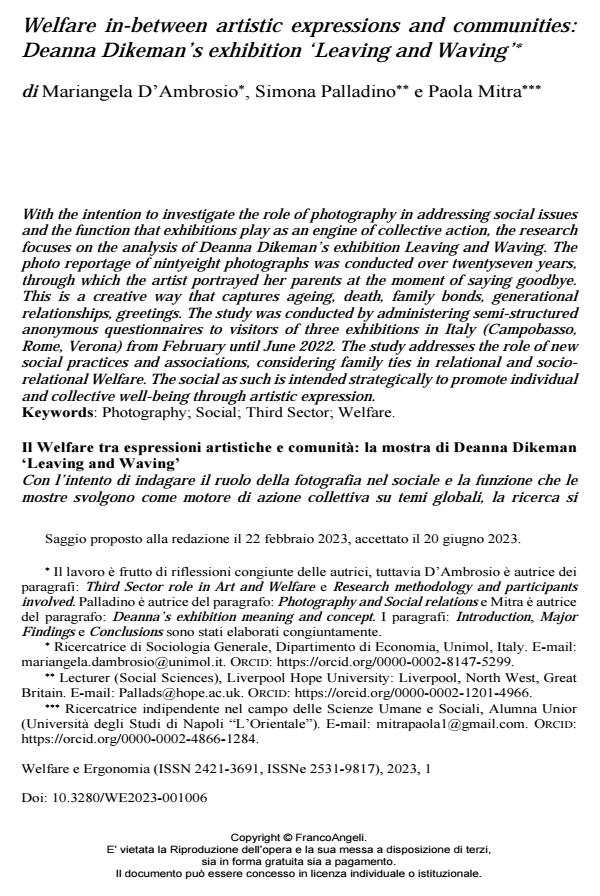Welfare in-between artistic expressions and communities: Deanna Dikeman’s exhibition "Leaving and Waving"
Titolo Rivista WELFARE E ERGONOMIA
Autori/Curatori Mariangela D’Ambrosio, Simona Palladino, Paola Mitra
Anno di pubblicazione 2023 Fascicolo 2023/1
Lingua Inglese Numero pagine 12 P. 75-86 Dimensione file 370 KB
DOI 10.3280/WE2023-001006
Il DOI è il codice a barre della proprietà intellettuale: per saperne di più
clicca qui
Qui sotto puoi vedere in anteprima la prima pagina di questo articolo.
Se questo articolo ti interessa, lo puoi acquistare (e scaricare in formato pdf) seguendo le facili indicazioni per acquistare il download credit. Acquista Download Credits per scaricare questo Articolo in formato PDF

FrancoAngeli è membro della Publishers International Linking Association, Inc (PILA)associazione indipendente e non profit per facilitare (attraverso i servizi tecnologici implementati da CrossRef.org) l’accesso degli studiosi ai contenuti digitali nelle pubblicazioni professionali e scientifiche
With the intention to investigate the role of photography in addressing social issues and the function that exhibitions play as an engine of collective action, the research focuses on the analysis of Deanna Dikeman’s exhibition Leaving and Waving. The photo reportage of nintyeight photographs was conducted over twentyseven years, through which the artist portrayed her parents at the moment of saying goodbye. This is a creative way that captures ageing, death, family bonds, generational relationships, greetings. The study was conducted by administering semi-structured anonymous questionnaires to visitors of three exhibitions in Italy (Campobasso, Rome, Verona) from February until June 2022. The study addresses the role of new social practices and associations, considering family ties in relational and socio-relational Welfare. The social as such is intended strategically to promote individual and collective well-being through artistic expression.
Con l’intento di indagare il ruolo della fotografia nel sociale e la funzione che le mostre svolgono come motore di azione collettiva su temi globali, la ricerca si concentra sull’analisi della mostra Leaving and Waving di Deanna Dikeman. Si tratta di un reportage fotografico di novantotto scatti, si pone su un continuum temporale di ventisette anni, dove l’artista ha ritratto i suoi genitori nel momento del saluto. Pertanto, una modalità creativa che tratta le tematiche dell’invecchia-mento, la morte, i rapporti familiari e generazionali, il saluto. Lo studio è stato condotto somministrando questionari anonimi semi-strutturati ai visitatori di tre mostre in Italia (Campobasso, Roma, Verona) da Febbraio a Giugno 2022. La ricerca fa luce sul ruolo delle associazioni per dare risalto all'importanza dei legami familiari in chiave relazionale e di Welfare socio-relazionale, strategico per promuovere il benessere individuale e collettivo tramite il linguaggio artistico.
Parole chiave:Fotografia; Sociale; Terzo Settore; Welfare.
- Addressing Uncomfortable Emotions through the Photo-Exhibition Leaving and Waving by Deanna Dikeman Simona Palladino, Mariangela D'Ambrosio, Paola Mitra, in Photography and Culture /2024 pp.57
DOI: 10.1080/17514517.2024.2324507
Mariangela D’Ambrosio, Simona Palladino, Paola Mitra, Welfare in-between artistic expressions and communities: Deanna Dikeman’s exhibition "Leaving and Waving" in "WELFARE E ERGONOMIA" 1/2023, pp 75-86, DOI: 10.3280/WE2023-001006